David Cook
Well-known member
For some weird reason, I keep buying Macintosh II series boards and computers. Recently, I purchased a sealed AppleService NOS IIx motherboard. I also purchased another lot that consisted of a Macintosh II upgraded to a IIx with the Macintosh II board separate.
Upgraded Macintosh II
The seller said "I could never get this machine to work. I bought a Macintosh II that had a logic board with memory, video card and no processor. The Macintosh II video card and power supply have been tested on a IIfx and they function. I bought a IIx logicboard, recapped it, added new batteries, but I never got this to work. Thus it is sold as described with no refunds."
I hesitated to buy this, as someone with some restoration skills had obviously given it a shot already.
For the most post, their recap was fine. The large electrolytic capacitors were soldered well to the top of the board. But, they missed a few places underneath -- but I don't think this prevented the board from working.
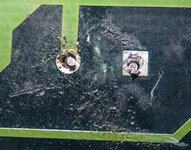
The replacement batteries had serviceable voltage. It looks like the previous owner soldered leads to the end of standard cells. I replaced these with battery holders. Here again, I don't think this prevented the board from working.
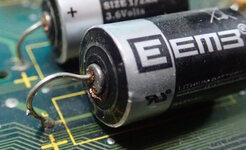
There were signs of rework on the underside of the clock/PRAM chip UB6. If there had been a problem, I would have expected them to socket the chip. (After I got the board working, I verified that the clock/PRAM was fine.)
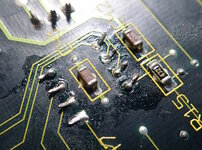
What Was Still Broken?
1. After ultrasonic cleaning, I inspected the trace that goes from the ADB power key, to the power switch, and then all the way back to UB1 and UB2 for the power circuit. On the Macintosh II and IIx, this line is always broken somewhere, because the line is energized by the batteries while sitting in capacitor juice.
There were three completely broken spots on the trace that needed to be replaced by buss wire, plus a few more spots that I scraped and tinned just in case.

2. The board was missing the ROM. This was a bummer, because it wasn't described in the listing and no pictures showed that location on the board. No big deal. I had a spare ROM from a board with upgraded memory and 32-clean ROM. Nevertheless, if the previous owner had forgotten to reinstall the ROM during testing, they would not have gotten it running.
3. At this point, the machine powered up the power supply, but didn't chime. If you hadn't installed a video card or drive on your test bench, you'd be forgiven for thinking the board still didn't work. The truth was weirder. The speaker measured 30 ohms, which is fine. A replacement speaker worked, but the original did not. Maybe a broken wire? Almost. One spring contact inside the speaker connector had broken off. I've never seen that before. I cut both old terminals and replaced them.
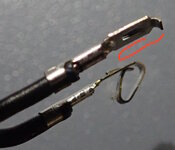
The IIx was working! Then, I broke it.
At some point, when I swapped the board in and out and in, I installed the internal SCSI terminator off by one row of pins. This shorted the terminator power supply to ground and blew fuse F1. Whoops!
Fortunately, someone recently posted about this. I can't find the post so I can't give credit. But, I remembered the tip was to replace the fuse with an auto-resetting PPTC fuse. The original fuse is rated at 1 amp. I chose a PPTC of approximately the same value, but it didn't work. The Bomarc schematic says 2A. So, I chose a larger current PPTC and it worked great.
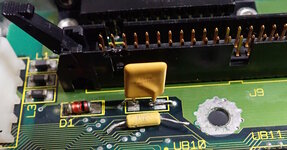
When I went to take this picture, I noticed the fuse is rated for 1A, not 2A. The Apple documentation says 1A as well. I've concluded that due to the differences in the speed in which different types of fuses blow, and since the PPTC has a confusing min, hold, and max trip point, that maybe the PPTC needs to be a bit overrated to be compatible.
Macintosh II
The Macintosh II board needed a lot more love. This was sort of tossed in as an extra, so it wasn't expected to be complete. As listed and pictured, it was missing a CPU, FPU, and memory. All the capacitors needed to be recapped and batteries needed replacing (and socketing).
As usual, the power switch trace was corroded broken in multiple locations.
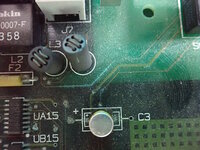
Hey! Notice fuse F2 on the left side of the above picture? I guess the Macintosh II and IIx had non-resettable fuses for ADB. That explains why Apple warned people to not connect and disconnect ADB devices with power on -- or they could damage the Macintosh. A blown fuse would need servicing.
The second issue with my Macintosh II board was also really common. UB1 and UB2 get corroded due to capacitor juice and battery power.
Pictured below, can you guess the extent of the damage?
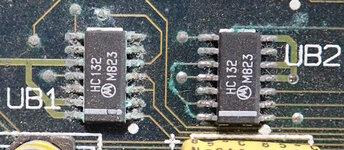
Below, the chips are removed and the corrosion is scraped off. A pin from the UB1 chip fell of prior to chip removal. The multimeter detected four complete breaks and a questionable trace.
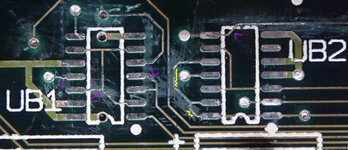
Neither chip is trustworthy. Since they are still available off the shelf, they have both been replaced with fresh chips. The broken traces have been mended with plain buss wire.

The Macintosh II lives again.
AppleService New-Old-Stock Macintosh IIx Motherboard
That takes us to the NOS Macintosh IIx Motherboard. I've seen these parts show up on eBay and I was curious what shape they would be in. Would it be magically perfect with a newer 32-bit clean ROM?
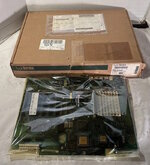
I was also interested in determining the date this board was manufactured. The box has many dates, because at some point it was reshipped. The 'Sealed Air' bag has a December 1991 date. This is a year after the IIx was discontinued. I feel like the remaining boards might have just been repackaged and sealed by AppleService at this later date.
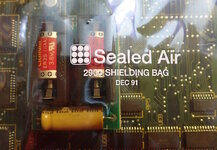
One frustration is that Apple did not supply the power-on button cap (see below). Why? This was also missing from the IIx at the beginning of the thread. Maybe the plastic cap was added to the boards when the computer was assembled, much like floppy drive and SCSI cables? So, it simply isn't a 'part' of the motherboard.
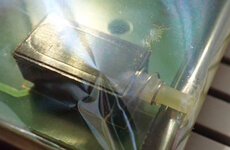
The 'sealed' bag became unsealed at some point due to a tear in the SCSI connector locking tab. As we will see, this might have actually saved the board from trapped capacitor juice gases.
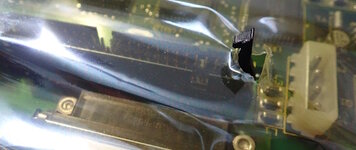
It is nice that the IIx board has the battery holder upgrade installed on it. The solder looks like a factory install rather than rework. The battery is dated 11-1989. I don't quite understand why batteries would be installed on replacement part stock.

A lot of the chips are dated around 1989. So, I'm going to guess this is a late 1989 / early 1990 IIx. The IIx was discontinued in October 1990. I wonder when they stopped manufacturing? Maybe in Spring 1990 when the IIfx shipped?
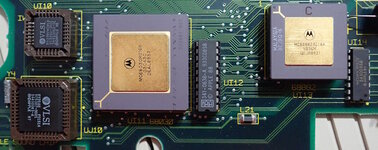
Corrosion on the power button trace exists, but is far cleaner than any other IIx boards I've seen.
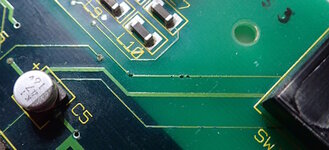
The power circuit is also cleaner than used IIx boards. However, the residue is unusual brown chips. The lack of usage avoided dust buildup in the chip leads. The lack of dust prevented capacitor juice from being soaked up and collecting there?
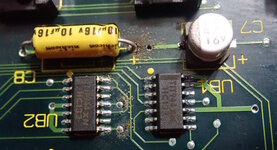
The sound chips are also much cleaner. But you can still see green corrosion.
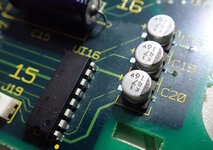
Ick! The chips nearest C10 have been coated and wetted such that their labels are no longer readable. This isn't a shadow. They really are dark and slimy. If the batteries had done this, I would expect the pattern to affect RP5 and less affect UD7 and UC7.
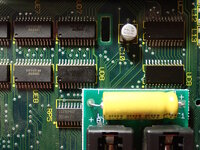
Ouch. UG1 has some encrusted pins.
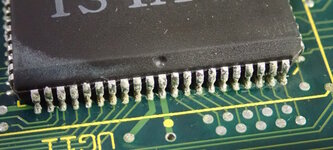
It looks like C12 is to blame.
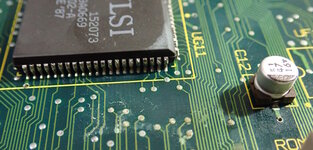
I conclude that old-enough AppleService sealed boards are still likely to be corroded. The extent of the damage may depend on storage temperature/humidity, as well as whether the air seal has been punctured. I can't decide if the board is more likely to be harmed by retaining the capacitor gases or due to exposure to outside air.
Lastly, the ROM supplied is newer looking, but contains the standard IIx 32-bit dirty image. Even though they had 32-bit clean ROMs at this point, I guess it wasn't worth the trouble to test it on a IIx and update the IIx boards they had in the service department.

In summary, I don't think I'd pay a premium for an AppleService board unless the seller opens it and posts clear pictures. The lack of dust is good, but the corrosion could still be significant. (In fairness, after cleaning and recapping, this board booted right up. No broken traces or components.)
- David
Upgraded Macintosh II
The seller said "I could never get this machine to work. I bought a Macintosh II that had a logic board with memory, video card and no processor. The Macintosh II video card and power supply have been tested on a IIfx and they function. I bought a IIx logicboard, recapped it, added new batteries, but I never got this to work. Thus it is sold as described with no refunds."
I hesitated to buy this, as someone with some restoration skills had obviously given it a shot already.
For the most post, their recap was fine. The large electrolytic capacitors were soldered well to the top of the board. But, they missed a few places underneath -- but I don't think this prevented the board from working.

The replacement batteries had serviceable voltage. It looks like the previous owner soldered leads to the end of standard cells. I replaced these with battery holders. Here again, I don't think this prevented the board from working.

There were signs of rework on the underside of the clock/PRAM chip UB6. If there had been a problem, I would have expected them to socket the chip. (After I got the board working, I verified that the clock/PRAM was fine.)

What Was Still Broken?
1. After ultrasonic cleaning, I inspected the trace that goes from the ADB power key, to the power switch, and then all the way back to UB1 and UB2 for the power circuit. On the Macintosh II and IIx, this line is always broken somewhere, because the line is energized by the batteries while sitting in capacitor juice.
There were three completely broken spots on the trace that needed to be replaced by buss wire, plus a few more spots that I scraped and tinned just in case.

2. The board was missing the ROM. This was a bummer, because it wasn't described in the listing and no pictures showed that location on the board. No big deal. I had a spare ROM from a board with upgraded memory and 32-clean ROM. Nevertheless, if the previous owner had forgotten to reinstall the ROM during testing, they would not have gotten it running.
3. At this point, the machine powered up the power supply, but didn't chime. If you hadn't installed a video card or drive on your test bench, you'd be forgiven for thinking the board still didn't work. The truth was weirder. The speaker measured 30 ohms, which is fine. A replacement speaker worked, but the original did not. Maybe a broken wire? Almost. One spring contact inside the speaker connector had broken off. I've never seen that before. I cut both old terminals and replaced them.

The IIx was working! Then, I broke it.
At some point, when I swapped the board in and out and in, I installed the internal SCSI terminator off by one row of pins. This shorted the terminator power supply to ground and blew fuse F1. Whoops!
Fortunately, someone recently posted about this. I can't find the post so I can't give credit. But, I remembered the tip was to replace the fuse with an auto-resetting PPTC fuse. The original fuse is rated at 1 amp. I chose a PPTC of approximately the same value, but it didn't work. The Bomarc schematic says 2A. So, I chose a larger current PPTC and it worked great.

When I went to take this picture, I noticed the fuse is rated for 1A, not 2A. The Apple documentation says 1A as well. I've concluded that due to the differences in the speed in which different types of fuses blow, and since the PPTC has a confusing min, hold, and max trip point, that maybe the PPTC needs to be a bit overrated to be compatible.
Macintosh II
The Macintosh II board needed a lot more love. This was sort of tossed in as an extra, so it wasn't expected to be complete. As listed and pictured, it was missing a CPU, FPU, and memory. All the capacitors needed to be recapped and batteries needed replacing (and socketing).
As usual, the power switch trace was corroded broken in multiple locations.

Hey! Notice fuse F2 on the left side of the above picture? I guess the Macintosh II and IIx had non-resettable fuses for ADB. That explains why Apple warned people to not connect and disconnect ADB devices with power on -- or they could damage the Macintosh. A blown fuse would need servicing.
The second issue with my Macintosh II board was also really common. UB1 and UB2 get corroded due to capacitor juice and battery power.
Pictured below, can you guess the extent of the damage?

Below, the chips are removed and the corrosion is scraped off. A pin from the UB1 chip fell of prior to chip removal. The multimeter detected four complete breaks and a questionable trace.

Neither chip is trustworthy. Since they are still available off the shelf, they have both been replaced with fresh chips. The broken traces have been mended with plain buss wire.

The Macintosh II lives again.
AppleService New-Old-Stock Macintosh IIx Motherboard
That takes us to the NOS Macintosh IIx Motherboard. I've seen these parts show up on eBay and I was curious what shape they would be in. Would it be magically perfect with a newer 32-bit clean ROM?

I was also interested in determining the date this board was manufactured. The box has many dates, because at some point it was reshipped. The 'Sealed Air' bag has a December 1991 date. This is a year after the IIx was discontinued. I feel like the remaining boards might have just been repackaged and sealed by AppleService at this later date.

One frustration is that Apple did not supply the power-on button cap (see below). Why? This was also missing from the IIx at the beginning of the thread. Maybe the plastic cap was added to the boards when the computer was assembled, much like floppy drive and SCSI cables? So, it simply isn't a 'part' of the motherboard.

The 'sealed' bag became unsealed at some point due to a tear in the SCSI connector locking tab. As we will see, this might have actually saved the board from trapped capacitor juice gases.

It is nice that the IIx board has the battery holder upgrade installed on it. The solder looks like a factory install rather than rework. The battery is dated 11-1989. I don't quite understand why batteries would be installed on replacement part stock.

A lot of the chips are dated around 1989. So, I'm going to guess this is a late 1989 / early 1990 IIx. The IIx was discontinued in October 1990. I wonder when they stopped manufacturing? Maybe in Spring 1990 when the IIfx shipped?

Corrosion on the power button trace exists, but is far cleaner than any other IIx boards I've seen.

The power circuit is also cleaner than used IIx boards. However, the residue is unusual brown chips. The lack of usage avoided dust buildup in the chip leads. The lack of dust prevented capacitor juice from being soaked up and collecting there?

The sound chips are also much cleaner. But you can still see green corrosion.

Ick! The chips nearest C10 have been coated and wetted such that their labels are no longer readable. This isn't a shadow. They really are dark and slimy. If the batteries had done this, I would expect the pattern to affect RP5 and less affect UD7 and UC7.

Ouch. UG1 has some encrusted pins.

It looks like C12 is to blame.

I conclude that old-enough AppleService sealed boards are still likely to be corroded. The extent of the damage may depend on storage temperature/humidity, as well as whether the air seal has been punctured. I can't decide if the board is more likely to be harmed by retaining the capacitor gases or due to exposure to outside air.
Lastly, the ROM supplied is newer looking, but contains the standard IIx 32-bit dirty image. Even though they had 32-bit clean ROMs at this point, I guess it wasn't worth the trouble to test it on a IIx and update the IIx boards they had in the service department.

In summary, I don't think I'd pay a premium for an AppleService board unless the seller opens it and posts clear pictures. The lack of dust is good, but the corrosion could still be significant. (In fairness, after cleaning and recapping, this board booted right up. No broken traces or components.)
- David
